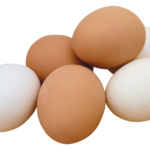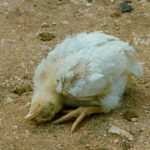Like diseases, chicken pests can affect productivity – both meat and eggs. They can also lead to death. It is therefore important to understand the common types and how to rid of them. The good thing is they are relatively easy to handle and eliminate. So here are the most common chicken pests and how to rid of them.

Chicken poop and decomposing food wastes attract flies to chicken coops and it is hard to not find them in any chicken coop. Their presence can also be encouraged by dirty water and food and water trays. This happens especially during the rainy seasons or if the coops get wet.
Types of flies to find in coops
Both the house fly and little flies are a problem to chicken populations. It also leaves specks on eggs in addition to spreading poultry and chicken diseases. The little house fly prefers less moist areas like poultry manure. You can find it around hanging objects inside coops, egg rooms, and feed rooms. The black garbage fly also loves cold weather as does little house fly. They have a shiny bronze-black appearance and are slightly smaller than the house fly.
The blue bottle flies – also called the blowflies – are green or blue or nearly black. They breed mostly in carcasses, dog manure, broken eggs, and wet garbage.
Effects of flies on chicken
But do they cause any health risk on poultry? Yes. They can cause Salmonella, Pasteurella, Campylobacter, and E. Coli bacteria, which have direct effects on chicken. If chickens feed on them, they can cause them to get Choanotaenia infundibulum tapeworms which starve chickens and affect productivity. Plus fly larvae can cause botulism in chickens when ingested.
How to control flies
- Keep the coop and areas very clean: The first thing is to keep the areas and coops clean. Change litter regularly and remove every dirty and wet thing that encourages flies. Ventilation of the coop also helps. You can also try the following.
- Mixing diatomaceous earth with fresh litter causes flies that come into contact to die of dehydration.
- If using a free-range or garden, have plants like lavender, rosemary, and mint that naturally repel flies. Make sure they are safe for chickens to eat – plants like tansy can be dangerous if consumed by chickens.
- Ensure to remove manual regularly – at least twice a week.
Prevent leaks in water troughs. - Adjust or raise the floor level if there is a danger of flooding.
Use antibiotics to control dysentery. - Monitor cages and birds and isolate sick and dispose of dead ones and eggs immediately.
- Use insecticides: Flytraps and strips are the safest options because they cannot contaminate or poison chicken feed. You can also hang them out of reach of chicken inside the coop.
Using sprays and larvicides is also effective in controlling the flies. However, these must never be sprayed on birds or close to their feed and water. Additionally, always keep them safely out of chicken reach. Larvicides are used to suppress maggot populations. Use cyromazine to control larvae. The latter can be blend into a poultry feed ration.
- Keep fly parasitoids: These feed on flies. The tiny wasps kill flies in the pupal stages. Others that can help control flies naturally include mites, beetles, hister beetle, and others.
4. Try mechanical traps: These include fly zappers, strips, and funnel-type traps. Use surveillance techniques like moving tape counts, larval sampling, flyspeck counts, baited jug traps, sticky fly tapes, and moving tape counts.
Buy Improved Kienyeji Chicken Farming Manual
Buy FEED FORMULATION

